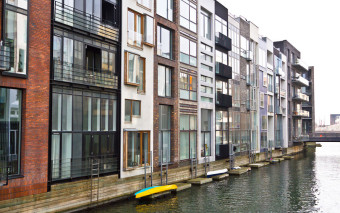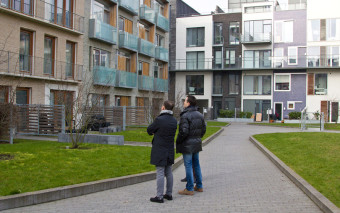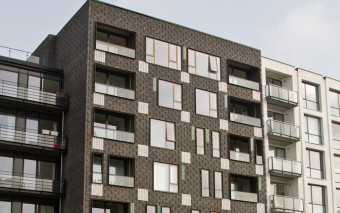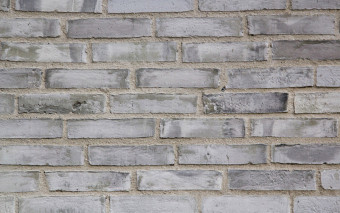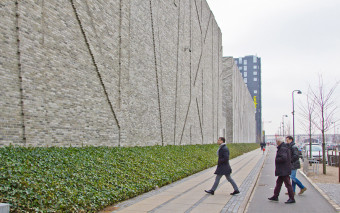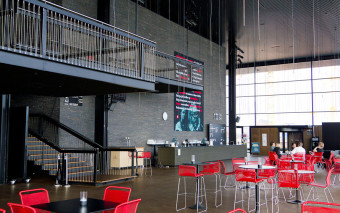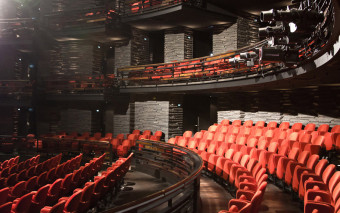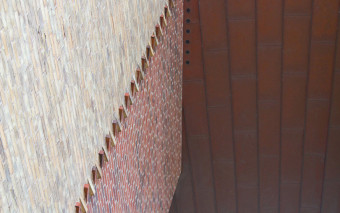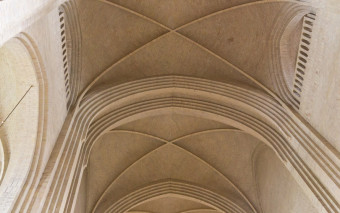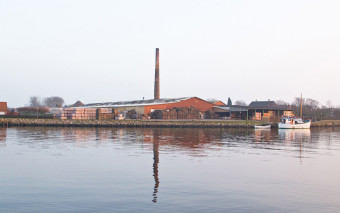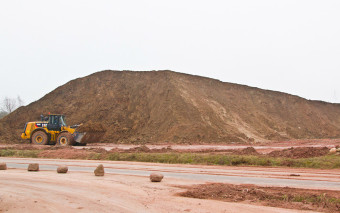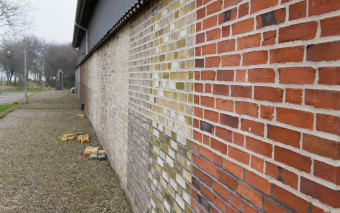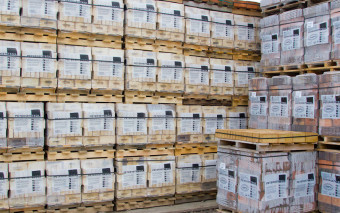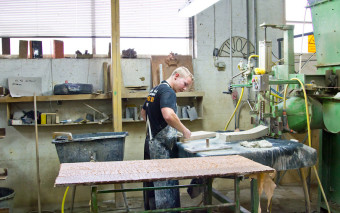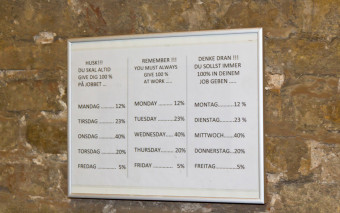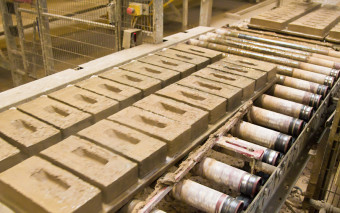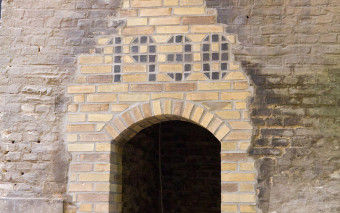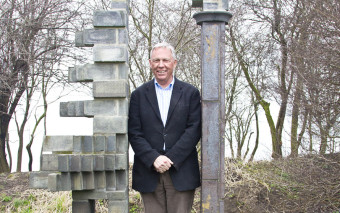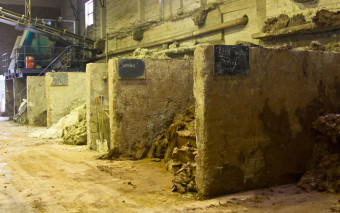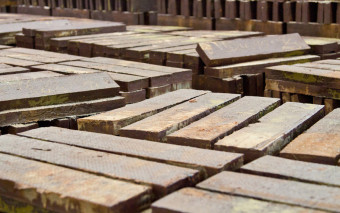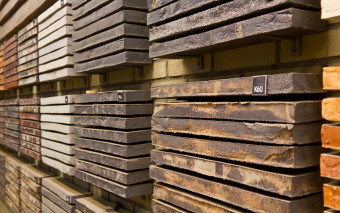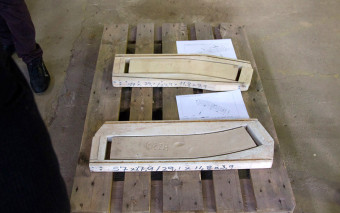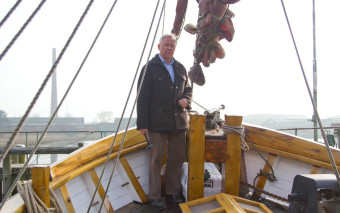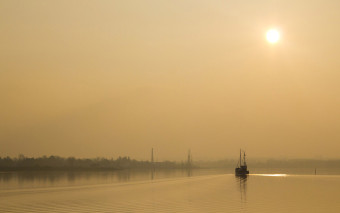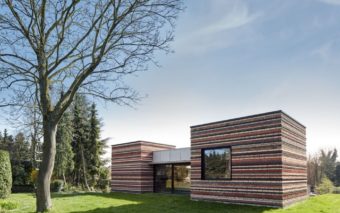Petersen-Tegl, haute couture del mattone a vista
Diario di tre giorni alla scoperta del facciavista danese
La famiglia Petersen produce mattoni da nove generazioni: fondata nel 1791, è una delle più antiche fornaci del nord Europa.
Lo scorso novembre abbiamo conosciuto a Milano Peter, membro della nona generazione (nonché papà della decima), e Francesco, ingegnere italiano che collabora da tempo con la società. Ai primi di marzo ci hanno invitati in Danimarca a visitare Copenaghen, dove il mattone Petersen è protagonista di molti progetti, e lo stabilimento di Nybøl Nor, dove è prodotto.
Copenaghen. Il facciavista, tra edifici storici e nuovi progetti
Che Copenaghen sia una città molto bella non è un segreto.
Ma l’occasione ce l’ha fatta osservare soprattutto con gli occhi di chi vive e ama il mattone a vista. E di mattone a vista ce n’è moltissimo.
Dagli edifici storici ai nuovi progetti, i rivestimenti in mattoni sono tanto presenti da essere un dato culturale.
È elemento comune agli edifici storici, come la vecchia borsa, e agli interventi più recenti come la riqualificazione di Sydhavnen. Al nuovo archivio di stato o al teatro di prosa (dove anche la sala è in facciavista, progettato per rispondere anche a esigenze acustiche). Veste gli appartamenti d’autore del Bispebjerg Bakke, complesso disegnato dallo scultore Bjørn Nørgaard o, più semplicemente, il nostro albergo, ricavato da un deposito portuale del diciottesimo secolo.

Senza dimenticare la stupefacente chiesa di Grundtvig, un’opera terminata negli anni ’40 che racchiude in sé ogni lavorazione possibile – e talvolta quasi impossibile – del facciavista. Una vera sorpresa, a cui dedicheremo un approfondimento.
Ma sono anche gli impieghi più estemporanei a dirci quanto il mattone sia tutt’uno con la cultura locale. Percorrendo Nørre Allé ci si imbatte in un parcheggio sotterraneo, segnalato in superficie da due edifici di pochi metri quadrati: e sono rivestiti dal mattone Kolumba™ – che è il più prestigioso fra i prodotti Petersen.
Se ci si guarda intorno, dei mattoni colpisce innanzitutto la varietà e tavolozza dei colori, molto diversi rispetto alle tonalità tipiche della terracotta mediterranea.
D’altronde, il colore è un elemento di coerenza con l’ambiente: così, le peculiarità di clima, luce e contesto si traducono nelle tonalità della faccia a vista. A Copenaghen il rigore di grigi e neri, l’ocra raffreddata sembrano le tonalità più naturali a interpretare luoghi e atmosfere; e il rosso tradizionale (il color mattone) da queste parti è denso e scuro, simile al colore del clinker.

Altro elemento evidente è la consistenza della malta, che spesso ha una grana molto grossa. Questa caratteristica, che rende più difficile la precisione nella posa e nella definizione delle fughe, restituisce un effetto d’insieme dove l’imperfezione è parte integrante del disegno.
Rispetto alla stratigrafia, la tecnologia della facciata ventilata è la norma: rispetto alla nostra esperienza, spesso non sono utilizzate le mensole di sostegno, mentre ci si affida ai soli ancoraggi.
Ma tornando al mattone, colpiscono soprattutto le sfumature di colore e le stonalizzazioni. Non è mai cercata l’omogeneità (la campitura perfettamente monocromatica della parete), e le facciate sono caratterizzate invece dalle gradazioni tonali del mattone – che, lo vedremo, sono il tratto caratteristico della produzione locale.

Petersen-Tegl. La produzione
Lo stabilimento Petersen-Tegl è a Nybøl Nor, sui fiordi meridionali, a circa 200 chilometri da Copenaghen. Un’area dove la produzione di mattoni è stata per secoli l’attività principale di molte famiglie – nel ’700 c’erano più di 50 fornaci.
Ad accoglierci c’era Christian Petersen, che oggi è a capo del gruppo. Rappresenta la settima generazione imprenditoriale della famiglia: a 70 anni, ha passione e vivacità che metterebbero in imbarazzo molti trentenni, e un patrimonio inesauribile di racconti e aneddoti.

Ci ha guidato attraverso due siti produttivi, a pochi chilometri di distanza l’uno dall’altro. Nel primo sono realizzati i classici mattoni Petersen. I macchinari, ci spiega Christian, li hanno progettati loro stessi per emulare la produzione a mano. In questo modo hanno la stessa morfologia di quelli artigianali, e non sono uniformi. È particolare anche l’agente di distacco con cui i mattoni sono estratti dallo stampo: invece della più comune sabbia usano l’acqua (infatti definiscono i loro mattoni «waterstruck»).
Soprattutto, è caratteristico il processo che rende possibile ottenere la vastissima varietà di colori e il peculiare aspetto grezzo che sono il marchio di fabbrica Petersen: la cottura con fuoco a carbone.
Grazie anche a questa lavorazione, oggi ci sono a catalogo mattoni classici con più di trenta tonalità diverse. Senza contare tutti i pezzi speciali e su misura, realizzati in qualsiasi colore e foggia, su richiesta. Compresi mattoni smaltati con finitura dorata o argentata. Una varietà e un impegno che Christian durante la visita definisce spesso «crazy», passandosi la mano di fronte alla faccia: ma ovviamente è molto compiaciuto della vena creativa della sua attività.
Il mattone classico, qui, ha misure diverse rispetto al nostro standard, ed è disponibile in tre taglie: 228x108x40, 220x105x65, 228x108x54).

Altra differenza rispetto alle nostre abitudini, è la prassi di pre-assemblare in fabbrica alcuni elementi (in particolare le volte e i voltini), che sono consegnati in cantiere già pronti al montaggio come pezzo unico.
All’esterno del capannone, nei cortili affacciati sui fiordi, fanno bella mostra di sé le campionature, dove si succedono colori e sfumature. Oltre a un giardino con installazioni in mattone a vista, in equilibrio tra object trouvée, opere concettuali e guasconeria, regalati da artisti, architetti, e dipendenti dell’azienda (come la specie di altare ricevuto da Christian per i suoi 70 anni).

Un breve tragitto in automobile, e andiamo a incontrare il prodotto Petersen più famoso, prodotto in un altro sito, poco distante.
È il mattone Kolumba™, nato intorno al 2000 da una suggestione tardogotica. Infatti è stato prodotto e usato per la prima volta nell’omonimo museo, il Kolumba di Colonia (museo dell’arcidiocesi), su richiesta dell’architetto Peter Zumthor, che cercava «un formato inconsueto, 4 x 21 x 54 centimetri, sottile, ampio e lungo, adatto a innestarsi nei muri medievali, ideale per realizzare murature di spessore complementari alla pietra, cui cromaticamente si rivolge» («Costruire in laterizio» gli ha dedicato un approfondimento). Proprio questo elemento inconsueto, come ripete spesso e con orgoglio Christian, ha cambiato la vita della Petersen.
Ogni Kolumba™ è formato a mano in casseforme di legno, e questo edificio è dedicato esclusivamente a lui: oltre alla produzione, ci sono pareti dedicate alle campionature e una «stanza delle argille»: un colpo d’occhio su argille con colori e caratteristiche diverse, provenienti da tutta Europa.

Anche nel caso del Kolumba™ , la varietà e la movimentazione dei colori è data dalla cottura con fuoco a carbone. Ma la prima caratteristica resta la lavorazione artigianale.
Per inciso, fare mattoni a mano è piuttosto faticoso: lo possiamo dire per esperienza diretta, visto che ci hanno fatto realizzare un Kolumba™ in prima persona. Abbiamo messo letteralmente le mani in pasta, poi lo abbiamo formato e firmato. Dopo la cottura ce lo spediranno, in ricordo di questa esperienza.
Esperienza segnata dalla passione con cui la famiglia Petersen vive il proprio mestiere e riesce a coinvolgere gli ospiti in un racconto corale fatto non solo dei suoi mattoni, ma dei luoghi e delle persone che li producono – «la mia gente» come dice Christian.
Ne abbiamo avuto conferma anche dopo la visita allo stabilimento, quando siamo stati invitati a cenare in barca al largo del fiordo, fra ottima cucina locale e buonumore.
[Il sito ufficiale del gruppo è en.petersen-gruppen.dk]
The Petersens have been making bricks for nine generations: the brickyard, founded back in 1791, is one of the more ancient in Northern Europe. Last November in Milan we met Peter, exponent of the ninth generation (and father of the tenth), and Francesco, an Italian engineer who has been collaborating for years with the Company. At the beginning of March they invited us to Denmark to visit Copenhagen, where the Petersen’s brick is predominant in many buildings, and the brickyard in Nybøl Nor, where it is produced.
Copenhagen. The facing bricks, between historical buildings and new projects
It’s no secret that Copenhagen is a beautiful city.
But we had the chance to watch it with the eye of who lives and loves the facing brick. And the city is full of facing bricks.
From historical buildings to new projects, the brick facades are so numerous to become almost a cultural heritage.
Te brick is a common element in the historic buildings, like the old Stock Exchange, and in the most recent ones, as the requalification of Sydhavne. But also in the new State archive or in the playhouse (where also the auditorium is made with facing bricks, designed to meet the acoustic needs). The bricks cover also the apartments of Bispebjerg Bakke, a complex designed by the sculptor Bjørn Nørgaard or, more simply, our hotel, housed in an eighteenth-century harbor warehouse.
Not to mention the amazing Church of Grundtvig, a work completed in the 40s that encapsulates each possible – and sometimes almost impossible – brickwork. A real surprise, to which we will devote further attention.
But above all it is the ordinary use that tells us how the brick is one with the local culture. Along Nørre Allé you come across an underground car park, signaled on the street with two buildings of a few square meters covered by the Kolumba™ brick – which is the most prestigious among the Petersen’s products.
If you look around, what stands out the most about bricks is their variety and color palette, very different from the typical shades of Mediterranean terracotta.
After all, the color is an element of congruence with the environment: thus, the peculiarities of climate, light, and context are reflected in the colors of the facing wall. In Copenhagen, the rigor of grays and blacks, the cold ocher shades seem more natural to convey places and atmospheres; also the traditional red (the brick color) around here is thick and dark, like the color of the clinker.
Another evident element is the consistency of the mortar, which often is quite coarse-grained. This feature, which makes the precision of the laying and the definition of the flights more difficult, returns an overall effect where the imperfection is an integral part of the design.
As regard to the stratigraphy, the ventilated façade technology here is the norm: compared to our experience, they don’t seem to often use support shelves, relying solely on anchors.
Going back to bricks: what primarily catches the eye are the nuances of color and shade differences. It is never sought the homogeneity (the perfectly monochromatic wall), instead the facades are characterized by tonal gradations of brick – which, as we shall see, are the hallmark of Petersen production.
Petersen-Tegl. The manufacturing
The brickyard Petersen-Tegl is in Nybøl Nor, on the southern fjords, about 200 kilometers from Copenhagen. That is an area where the production of bricks was for centuries the main activity of many families – in 700 there were more than 50 furnaces.
Christian Petersen, who is now at the head of the group, welcomed us. He represents the seventh generation of the family business: 72 years old, passion and vitality that would embarrass many thirty-something, and an inexhaustible repertoire of stories and anecdotes.
He drove us through two production sites, a few kilometers away from each other. The first is where the classic Petersen bricks are made. They designed the machines by themselves, as Christian explains, in order to emulate the hand production. In this way the bricks have the same morphology as the artisan ones, and are not uniform. It is peculiar also the detachment agent with which the bricks are extracted from the mold: instead of sand they use water (indeed they define their brick “waterstruck”).
Above all, it is very characteristic the process that enables to obtain a wide variety of colors and the peculiar rough appearance that are the trademark of Petersen: the charcoal fire cooking.
Thanks to this process, today the classic brick catalog contains more than thirty different shades. Not to mention all the special or tailor-made pieces, realized in any color and style upon request. Including glazed brick finish with gold or silver. A variety and a commitment which during the visit Christian often defines “crazy”, waving his hand in front of his forehead, but he is obviously very pleased with – and proud of – the creativity of his business.
The classic brick here has different dimensions than our standard, and is available in three sizes: 228x108x40, 220x105x65, 228x108x54.
Another difference with our own procedure, is the practice of pre-assembling at the factory some elements (in particular vaults), which are delivered to the construction site as a single piece ready for installation.
Outside the building, in the courtyards overlooking the fjord, the samples with degrading colors and shades are proudly displayed. As well as a garden full of facing brick installations, a balance between object trouvée, conceptual works and humour, donated by artists, architects, and employees (for example the sort of altar received by Christian for his 70th birthday).
A short car ride and we can meet the most famous Petersen product, made in another site, not so far away.
It is the Kolumba™ brick, born around 2000 and inspired by a late Gothic suggestion. It was produced for and used for the first time in a Cologne museum, the Kolumba (museum of the Archdiocese), at the request of the architect Peter Zumthor. He sought «an unusual format, 4 x 21 x 54 cm , thin, deep and long , suitable for be inserted in the medieval walls, ideal for making thick walls complementary to the stone ones, which they complete chromatically» (the Italian magazine “Costruire in laterizio” devoted it a study ). This very unusual item, as Christian often repeats proudly, changed the future of the Petersen Tegl.
Each Kolumba™ is handmade in a wooden formwork , and the building is devoted exclusively to it: in addition to production, there are walls dedicated to sampling and a “room of the clays”: a glimpse of clays from all over Europe, with different colors and characteristics.
Even for the Kolumba™ , the variety and diversity of colors is given by cooking it with charcoal fire. But its main feature is the craftsmanship.
Incidentally, making bricks by hand is pretty hard: we can say that from personal experience, since we have to make a Kolumba™ firsthand. We literally put our hands in the dough, then we formed and signed our brick. After the baking, they will send it to us, as memory of this experience.
Experience marked by the passion with which the Petersen family lives its job and manages to engage the guests in a choral narration made not only of its bricks, but of the places and the people who make them – “my people,” as Christian uses to say.
All that was confirmed after the visit to the factory, when we were invited to dinner in their private boat off the coast of the fjord, tasting excellent local cuisine and enjoying good humor.
Hai bisogno di informazioni? chiamaci al +39 02.91084240 o scrivici a info@candelacostruzioni.it.


![Il mattone nell’architettura cinese contemporanea: 3 esempi [facciavista #16]](http://www.candelacostruzioni.it/blog/wp-content/uploads/2017/05/20_鸟瞰-340x213.jpg)

